-
Marco Antonetto, Made in Italy -- As the name implies, this is a book
about cameras made in Italy. It covers models from Daguerreotypes up
to the 1950 era and explores some subminis, such as the Gami and the Ducati.
See Mario Malavolti below.
-
Michel Auer, The Illustrated History of the Camera (1975) -- A large,
coffee-table-style book, covering the history of camera development. Very
well done, with impressive photos. It has one chapter on subminis and
another on detective cameras. 285 pages.
-
John Baird, Collectors Guide to Kuribayashi-Petri Cameras -- Covers
the entire line, from pre-war folders thru the last of the Petri line. Perti
made several half-frame cameras. Includes some information on lenses
and accessories.
-
Claude Bellon, Robot Historica -- It must be a recent book since it
covers models up to 1994. There are over 300 glossy pages of detailed data,
photos facts, field findings and collectors essentials on the German Robot
cameras. Starting in 1934, not all of the Robots were true subminis, but
all were interesting and unique.
-
Brian Coe, Cameras: from daguerreotypes to instant pictures (1978) --
This 240 page is a book of photographic equipment history. It has over 600
drawings of cameras and inner workings. Chapters are: The evolution
of photography --Early photographic apparatus --Folding stand cameras --Hand
plate cameras --Concealed cameras --magazines and multiple images --Early
roll film images --Roll film box cameras --The 35mm camera --small and miniature
cameras --The Reflex camera --Twin lens Cameras --Stereoscope Cameras --Panoramic
Cameras --Processing in the camera --Lenses --Shutters --Exposure meters
--and flash equipment.
-
Philip Condax , The Evolution of the Japanese Camera (1984) -- Put out
by Kodak and the George Eastman International Museum of Photography, this
book briefly describes -- in chronological order -- the Japanese cameras
that made photographic history. Many of them were subminiatures, of
course. There are hundreds of cameras listed and hundreds of pictures,
but the details on each camera are brief. The information covered pertains
to the unique features of the camera that made it historically important.
It has 101 pages. It should not be confused with the book by Yoichi
Kozasa, The Evolution of Camera.
-
Joseph D. Cooper, Fujica Camera Guide -- See Fujica 35mm Camera Guide
by Kathy Wersen (below).
-
Joseph D. Cooper, Mamiya-16 Camera Guide --
The only book on the Mamiyas. The cameras covered are only the Mamiya
16 Deluxe and the Mamiya 16 Automatic, but it covers them well. No
mention is made of other previous models, nor the last one -- the Deluxe
16 EE. It is a great book for those models and covers general
submini technique very well -- like all of Joe's books.
-
Joseph D. Cooper, The Minox Manual, 1961, 1964, 1968 -- Covers the B
and III-S. Each edition is somewhat different. The first
edition and the second edition both have 160
pages, while the third edition has 191 pages. It
is a great book for those models and covers general submini technique
very well -- like all of Joe's books.
-
Joseph D. Cooper, The Minox Pocket Companion, 1962, 1964, 1966 -- Who
says "You can't take it with you!" This ultra-miniaturized book (3x5
inches), will go anywhere your Minox does. As a true field-guide, it's organized
to answer your problems quickly.
-
Joseph D. Cooper, Minolta-16 Camera Guide, 1960
-- This is a fairly confusing publication for people. There are three
books that deal with Minolta subminis -- the first was Minolta Camera Guide
by Kenneth Tydings in 1959 which dealt with all Minolta camera models at
the time, including the Minolta 16 (model I). Shortly after that Joe
Cooper authored the Minolta-16 Camera Guide which dealt only with 16mm models
(at that time, just the model I and model II). Later Ted Rosenberg
came out with the Minolta 16 Guide which covered all of the Minolta 16 models.
No wonder so many people are confused. Cooper's book covered
Minolta models up to 1960 -- the 16 I and the 16II. It is a great book for
those models and covers general submini technique very well -- like
all of Joe's books. It has 112 pages.
-
Joseph D. Cooper, The Minolta Guide, 1959 --
This was Cooper's first book on Minolta cameras and covered all of Minolta's
camera models available in 1959 -- TLR's, SLR's, 35mm rangefinders and the
Minolta 16 I. In many ways it is a general book on photography, but
discusses the details as they pertain to Minolta cameras. It is a great
book for those models and covers general submini technique very well
-- like all of Joe's books. The last chapter is dedicated to the Minolta
16 I. It has 160 pages.
-
Joseph D. Cooper, Olympus Camera Guide, 1962 -- You didn't think that
old Joe would skip Olympus cameras did you? I wonder how he found time
to sleep! Anyway, this book covers the Olympus cameras of the time
and a couple of Pen half-frames -- the Original Pen and the Pen EE.
Otherwise it is mostly a genral photography book with details specific
to the Olympus line of cameras at that time. It has 128 pages.
-
Joseph D. Cooper, Ultra-Miniature Photography
,1958 -- A complete guide to the subminis of the time. While it
does go into detail about several particular submini models, it concentrates
mainly on technique, and is useful no matter what camera you own. It has
160 pages.
-
Joseph D. Cooper, The New Ultra-Miniature
Photography , 1961 -- This is an updated version of the 1958 edition
and covers the newer submini cameras -- even half-frames and Tessina. While
it does go into detail about several particular submini models, it concentrates
mainly on technique. It is useful no matter what camera you own. If
you want to know as much as you can about submini technique, this is the
book! It has 160 pages.
-
Prince R. de Croÿ-Roelx, Cameras: Macchine Fotografiche, 1997
-- It's obvious that this guy has too much time on his hands, but we appreciate
his efforts. In over 100 color photographs, the newest volume to the
Bella Cosa series features an extensive collection of beautiful portable
cameras. The classics used by the masters, the whimsical bellows of a 1908
model, a 1950 spy camera disguised as a lighter are but some of the beauties
featured in this pictorial history of the portable camera. This book
features photographs and decription of many rare and old cameras in both
English and Italian, as well as many subminiatures. In the 140 pages are
featured Robot, Vanity, Mercury, Coronet, Expo, Ticka, Photoret, Minox, Minicord,
Petal, Steineck ABC, CameraLite, Micro16, Compass, Golden Ricoh, Mikroma,
and Tessina.
-
Peter Dechert, Collecting and Using Olympus Pen Single Lens Reflex Cameras
-- It's the only book that covers the incredible Olympus Pen F series, and
should be titled "Everything you ever wanted to know about the Pen F's".
It covers the various models in detail and then goes on to discuss
how to modify the cameras for even more versatility. Sixty four
information-packed pages with many pictures.
-
Therese M. Donnelly, Guide to the 1980's Disc Camera: A Contribution to Camera History (2020) --
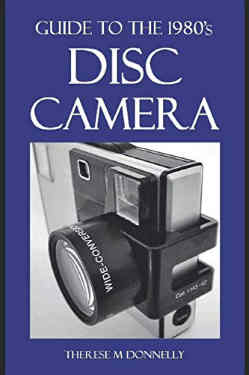
The disc camera, with its appealing and innovative design and revolutionary circular film format, entirely justifies its place in camera history.
Until now there has been little information available to help anyone buying or selling a disc camera. The aim of this illustrated Guide is to
show buyers and sellers what disc cameras and associated accessories and novelty items were produced, help estimate their worth, and suggest
whether their value is likely to increase in the future. This first ever Disc Camera Guide will show you what to look for and help you spot a bargain.
Every effort has been made to produce a Guide with accurate, verifiable information which is as complete as possible. The Guide
brings together authoritative information from an extensive range of worldwide sources including photographic and consumer magazines from the 1980s, library
archives, private collections, local auction houses, online auctions, used-camera dealers, manufacturers and distributors, disc camera instruction
booklets, and examples of the cameras themselves.
-
W.D. Emanuel, Minox Guide, 1957, 1958, 1960, 1961, 1974 -- The first
edition (1957) covers models before the B. The second edition (1958,
1960, 1961) covers up to the model B. The third edition (1974) get
to the BL and C models. Very "big" with the Minox crowd however "small"
they might be in other ways.
-
W.D. Emanuel, Robot Guide, 1949 -- It only covers the Model I and II
and it only has 72 pages, but beggars can't be choosers.
-
Art Evans, Collector's Guide to Rollei Cameras, 1986 -- Like other
"manufacturer" guides, it includes a brief history of the company and then
explores the many Rollei cameras -- medium format to submini. It's
full of pictures, serial numbers and camera specs about all of the Rollei
cameras. It includes the Rollei subminis, such as the Rollei 16 cameras
and the Rollei 110 cameras. It has two hundred and seventy pages of
pictures and detailed text!
-
John Foster, Olympus Viewfinder
Pen Cameras, 2000 --
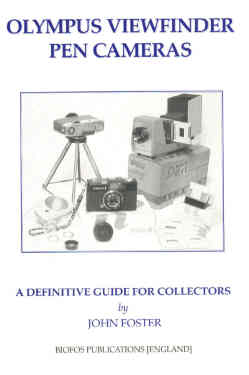
A true labor of love, this book goes into incredible detail on all
of the viewfinder Pen cameras (non SLR) from 1959 to 1986. It's 162 pages
with tons, I mean TONS, of detailed specifics and great shots from every
angle imagineable. If you are a Pen lover you need this book.
-
Jerry Friedman, The Complete Half Frame Guide (1998) -- This book covers
35mm half frame cameras, as well as paper-backed Bolta 35mm film. More than
just a listing of cameras, the book presents a concise history of the half-frame
camera from the end of the last century to today as well as an alphabetical
guide and description of all half-frame cameras with references for further
investigation. Even more, this book covers BOTH half frame formats, the single
frame 18x24mm image as well as the wider 24x24mm size cameras. Fully
illustrated.
-
Jerry Friedman, The New Subminiature Camera and Darkroom Guide (1996,
1998) -- Like several other submini books, this one begins by describing
several common submini camera models -- a few 9.5mm, several 16mm and the
two Tessina models. After that, it covers the basics of using these
cameras today -- finding cassettes, slitting film and reloading cassettes.
This is followed up with an explanation of darkroom work -- exposure
and developing of film, making enlargements, darkroom chemicals and equipment.
A good summary of using subminis today (109 pages). The second
edition has 93 pages of text and 24 full pages of illustrations.
-
T.L Green, Ultra Miniature Camera Technique (1965) --
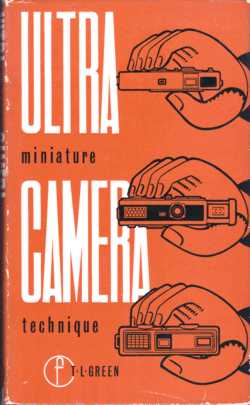
While it does not get into the details of any specific submini camera model,
it goes into detail about getting the most out of your small camera(s). It
covers the use of these cameras today -- finding cassettes, slitting film
and reloading cassettes. This is followed up with an explanation of
darkroom work -- exposure and developing of film, making enlargements, darkroom
chemicals and equipment. A good summary of using subminis today (120
pages) with lots of photos, diagrams, and formulas. Similar in many ways
to Cooper and Wahl's earlier books.
-
Hubert Heckman, Minox Variations in 8x11 -- Heckmann's "Minox Variations
in 8 x 11" is the latest addition to Minoxlore, published by Wittig Books
in Germany, an English translation of "Minox" from German. This book is published
as "50 years Anniversary Minox GmbH Edition" . The book has an introduction
by Walter Zapp. It covers the history of Minox and Minox GmbH, from Riga,
A ( II, III. IIIs),B, BL,C LX, EC to Minox AX.. It also covers all Minox
accessories from old film box, Riga enlarger to Minox advertising materials
such as posters etc. This is probably the most up-to-date book on everything
about Minox. 192 pages.
-
Richard Henry, Controls in Black and White Photography (1983, 1986)
-- After a career as a much published researcher in clinical chemistry, Dr.
Henry turned to photography. He was appalled by the lack of scientific rigor
in popular books and articles written by non-scientific photographers. "They
frequently make statements of fact which are totally unsubstantiated and
sometimes utterly absurd." So he equipped his laboratory with sophisticated
testing equipment and set about checking much that is commonly "known" about
photography. "Nearly all the experimental work performed for this book was
done with step wedges, etc. -- not pictures. In most instances, but not all,
a picture actually gets in the way of accurate measurements that need to
be made regarding the performance of film and paper." Following good
scientific practice, Dr Henry mentions assertions of others, cites references,
describes his experiments so others can replicate them, and reports conclusions.
This is a refreshing contrast to the approach of writers who imply that because
they are excellent photographers, readers should believe their unsupported
opinions. Among the findings that contradict popular myths are:
-
1.The maximum black a paper can make does not depend on its silver
content.
-
2.There is no difference in print values produced by condenser and cold
light enlargers if negatives for the latter are developed longer to make
print contrast the same.
-
3.Prolonged print development in Dektol does not increase contrast;
it only makes a print darker.
-
4.Dissolved solids, such as silver salts, do not sink to the bottom
of a print washer.
-
5.Amidol does not produce darker blacks than Dektol 1+1.
In addition to debunking false beliefs, the book contains much that
will be new to most readers. The second edition is 120 pages longer than
the first. Among the new or expanded topics are safety in the darkroom,
uniformity of film development, exposure meters, determination of film speed,
and a chapter on graininess, sharpness, and resolving power, and the effects
of various developers and developing conditions. The test data are generally
presented concisely in plots. Those who haven't come to appreciate the clarity
this allows will still benefit from the verbal descriptions of results and
conclusions. This book is extremely valuable for anyone who is seriously
interested in making black-and-white photographs -- especially from small
negatives. It is a special joy for already well-informed photographers
to find so much new information.
-
Rolf Kasemeier, Small Minox Big Pictures, 1957,
1966, 1970, 1971 -- The English version, was translated from the German by
E.F.Linssen and published by Heering-Verlag - Hardcover, 110 x 150mm, B&W
(some details printed in red) and 316 high illustrated pages. There are really
two versions of this book. The first edition was published in 1957 and most
of the procedures and accessories were based on the Minox-B model. The 1971
edition was revised and updated for the new features of the Minox BL and
C (notably the autoexposure), but some particular features of the previous
models are mentioned when necessary. This book is basically aimed to the
Minox user, not the collector. But it's also a highly collectable item, because
this book was released while the Minox history was still being written, that
means, it's part of Minox history.
-
Yoichi Kozasa, The Evolution of Camera, 1998 -- Another one of those
"rich guys with lots of cameras and too much time on his hands" books.
He's put together a small format book of his camera collection of cameras
from around the world -- in all formats. A few of these happen to be
submini. The pictures are nice, but small. The highlight is his
collection of Ricoh Auto-Half cameras. The book has 256 pages. It should
not be confused with the much more in depth book, The Evolution of the Japanese
Camera, by Condax.
-
Kalton Lahue, Collecting Vintage Cameras, 1972 -- Actually, this "book"
consists of several volumes, such as "The American 35mm". Individual
chapters cover manufacturers and many subminis are covered.
-
Kalton Lahue, Pocket Camera Photography, 1973
-- This book is often confused with his 1976 book called 110 Format Photography,
but the later book dealt exclusively with 110 cameras and should not be thought
of as a second edition of this book. This book covers the submini cameras
(smaller than half-frame) available in 1973, such as several Minolta 16mm
cameras, the Minox BL and C, the Yashica Atoron, and the Tessina. The
Kodak Pocket Instamatics had just come out and the first series is also covered.
It covers general submini techniques -- from choosing a camera, to
selecting films, and developing film -- very well. It has 80 pages.
-
Kalton Lahue, 110 Format Photography, 1976 -- Undoubtedly the most in-depth
book dealing with 110 format photography. It came out before the high-end
Minoltas and Pentaxes hit the market, so many models are not covered, but
it covers general 110 technique fully.
-
Michael Langford, The Pocket Camera Handbook, 1980 -- A introductory
guide to photography using 110, 126, and simple 35mm cameras. It covers using
the cameras, getting better pictures, and handling different subjects from
the perspective of the pocket photographer. It has 92 pages and lots
of pictures (most of which were obviously taken with a larger format camera).
Designed for the person who wants a small, fast camera -- and a small,
fast book to figure out how to use it.
-
Eaton Lothrop, A History of Detective and Concealed Cameras, 1973 --
Descriptions and pictures of 100 cameras from 1839 to 1939. Published
by the Eastman museum, it includes many submini and concealed cameras. 150
pages.
-
Eaton Lothrop, Geheimkameras und ihre abenteuerliche Geschichte, 1978
-- This is a book on concealed cameras. From the beginnings of the
Detective Cameras to, just to name a few, Hat - Shoe -Binocular - Walking
stick - Watch - Book - Compact - Leatherbag - Revolver - Pistol - Lighter
- Pen - Radio etc. 176 pages, GERMAN TEXT.
-
Richard Lowell, Yashica Guide, 1958,1959 --This is a general book on
photography, but discusses the details as they pertain to Yashica cameras.
It is often confused with the Advanced Yashica Guide by Kenneth Tydings
which came out at the same time. It devotes one chapter to the Yashica
Y16. It has 136 pages.
-
Mario Malavolti, Le Fotocamere Italiane Subminiatura (1995) -- A book
on Italian subminiture cameras. The text is in Italian with "specs" in English,
as well. Some of the companies and cameras described are: Bencini; C.O.M.I;
Ducati; F.A.F.-Moretti; Ferrania-3M; Ferro; Officine Galileo-GAMI; G.P.M.;
I.S.O; O.M.I; San Giorgio; San Marco; S.C.A.T; Speich.
-
James McKeown, Collector's Guide to Kodak Cameras -- not a price guide
(like his other books) -- this book has a fantastic amount of detail and
illustration. Kodak DID make subminis afterall.
-
James McKeown, McKeown's Price Guide to Antique and Classic Cameras,
1995/1996, 1997/1998 -- The BLUE BOOK of photography comes out every other
year (or so). It doesn't have every camera (it's short on cameras after 1970),
but it is the most complete list available -- over 10,000 models. Thousands
of (low-quality) pictures, plus descriptions and pricing info. Don't
leave home without it!
-
Keith Melton, The Ultimate Spy Book, 1996 -- Not just a book on cameras,
but photography did (and does) play a big part in espionage. It covers the
ultimate spy gadgets, but they are very dated and are definitely not
state-of-the-art! A nice history lesson and lots of great pictures. If only
for the cameras, well worth a look. But don't rely on this book for accurate
camera data.
-
Keith Melton and Vladimir Alekseenko, The Secret History of KGB Spy
Cameras: 1945–1995, 2018 --
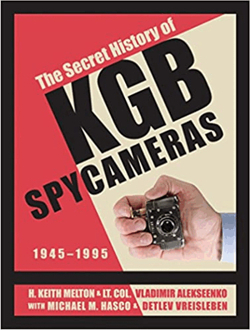
This lavishly photographed and authoritarian -- OOPS, I mean authoritative
-- book presents the secret history of Soviet subminiature spy cameras during
the Cold War. It is a history that could only have been written by the veteran
KGB technical intelligence officers who created and used the cameras in secret
operations. With 400 photographs, the book reveals the history, development,
and operational use of more than ninety secret cameras used by two of the
world’s most formidable intelligence services—the KGB (Komitet
Gosudarstvennoy Bezopasnosti [Committee for State Security]) and GRU (Glavnoye
Razvedyvatel'noye Upravleniye [Foreign Military Intelligence Agency of the
Soviet Army])—for secretly copying documents, and for surveillance and
compromise. Every major camera system used by the KGB, and several used by
the GRU are included. A bonus at the end of the book is an exhaustive glossary
on KGB and GRU photographic systems and optical devices. This book is a must-have
for camera collectors, military enthusiasts, historians, and counterintelligence
officers.
-
Morris Moses, Spy Camera: The Minox Story, 1990, 1998 -- Moses tells
the story of Walter Zapp and his vision of a high-quality, very small camera
that the well-dressed lady or gentleman could always carry. From pre-war
production in Latvia, the post-war move to Germany, to the present day, all
models are described in considerable detail. Amid the descriptions
and technical information are tales of the cameras use in covert activities,
and reproductions of pictures taken with the Minox, often filmed surreptitiously,
and sometimes illegally. The first edition
has 194 pages while the second edition has 224
pages and brings everything up-to-date. If you have a Minox, you'll
want this book.
-
Mike Parker, The Hit Project: A Reference
to the classic japanese novelty camera, 2003 --
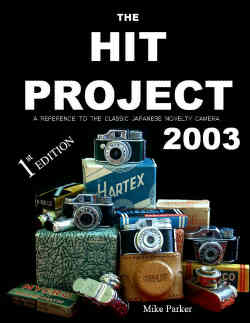
If you are interested in Hit-type cameras, look no further. This book
goes into incredible detail on all of the various Hit-type cameras. It's
loaded with pictures and even comes with a CD. It's about time someone
tried to provide some order to this area of collecting.
-
Cyril Permutt, Collecting Old Cameras, 1975 -- A good starting book
for the collector of older cameras. Chapter Seven deals just with
subminiature cameras. 200 pages.
-
Jean Princelle, Russian and Soviet Cameras , 1995 -- I had no idea the
Ruskies made so MANY submini cameras! My parents told me all they made
were BOMBS. Imagine how surprised I was! This book covers each
camera factory -- as a chapter -- and provides pictures, production numbers
and much more. Most of the cameras are NOT subminis. It does
not discuss technique, but does provide pictures, production details and
historical tidbits.
-
Michael Pritchard, Spy Camera: A Century of Detective
and Subminiature Cameras, 1993 -- It covers all the cameras (about 400)
that were sold at the "recent" Christie's submini auction. A well-illustrated
tour -- by country -- of different, interesting, unusual subminiature cameras.
Does not discuss technique, but definitely gets the juices flowing
with superb photos.
-
Ed Romney, Basic Training in Camera
Repair -- It covers Compur, Copal and most other leaf shutters, cloth
and metal focal plane shutters, rangefinders, autofocus systems, meters,
mirrors, lenses, wind systems, testing, cleaning, lubrication and adjustment.
It uses a systems approach so you can fix most cameras. Easy to understand.
No higher math. And who knows, you might even be able to fix that piece of
junk!
-
Ted Rosenberg, Minolta 16 Guide, 1973
--
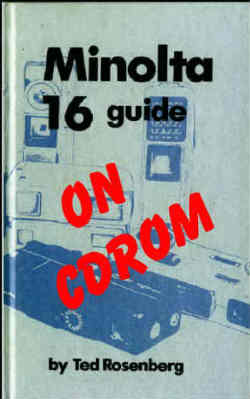
This is a fairly confusing publication for people. There are three
books that deal with Minolta subminis -- the first was Minolta Camera Guide
by Kenneth Tydings in 1959 which dealt with all Minolta camera models at
the time, including the Minolta 16 (model I). Shortly after that Joe
Cooper authored the Minolta-16 Camera Guide which dealt only with 16mm models
(at that time, just the model I and model II). Later Ted Rosenberg
came out with the Minolta 16 Guide which covered
all of the Minolta 16 models. If you have a Minolta, you need this book.
-
Robert Rotoloni, Nikon Rangefinder Cameras -- This book is an illustrated
history of the Nikon rangefinder cameras, lenses and accessories. It's
listed here since one of the models was a half-frame camera.
-
Kate Rouse, The First-time Collector's Guide to Classic Cameras, 1994
-- Collecting things (and I mean everything) seems to have become the latest
fad. So it was just a matter of time before someone came out with a book
on camera collecting. Towards this end, it offers the first-time collector
tips on what to look for, how to spot fakes, how to negotiate the best price,
etc. It has several large pictures of various cameras, but covers only a
few subminis, such as Minox, Steky, Pen F, Robot and Minolta 110. It gives
very little detail about any particular camera, but has some nice
pictures.
-
Kate Rouse, Classic Cameras, 2002 -- More or less a rehash of her first
book, like it's predicessor, this book offers the first-time collector tips
on what to look for, how to spot fakes, how to negotiate the best price,
etc. It has several large pictures of various cameras, but covers only a
few subminis, such as Minox, Steky, Pen F, Robot and Minolta 110. It gives
very little detail about any particular camera, but has some nice pictures.
80 pages.
-
Jason Schneider, Jason Schneider on Camera Collecting -- Three paperback
volumes that are a collection of his columns from Modern Photography. These
are interesting reading, but are vignettes of camera history and tidbits
of information, not in-depth information about any particular camera
line.
-
Carl Shipman, How to select and use Minolta SLR Cameras, 1980 -- This
208-page book has sections on the Minolta 110 Zoom SLR and the Mark II.
-
Carl Shipman, How to select and use Pentax SLR Cameras, 1977, 1979,
1980, 1981, 1982 -- At least the later editions of this book have a section
on the Pentax 110 SLR
-
Koichi Sugiyama, The Collector's Guide to Japanese Cameras, 1985 --
Covers, very, very briefly, Japanese cameras of all formats, from 1845 through
1984. It has a photo of each camera and leaves very few out (mostly cameras
from the last decade or two). It's pricey, but a collector's dream. Many
of the camera models in the book had different designations in the US
market.
-
Suglob Victor, Shaternik & Kochergin, 1200 Cameras from USSR, 2009
-- In 650 pages, it covers all of the basic manufacturers of the Soviet cameras,
lenses and accessories from the 1920's until 1991. And, of course, many were
subminis. Not easy to get but a "must" for the collector of Soviet cameras.
It may only be available in Russian.
-
Thomas Tomosy, Camera Maintenance and Repair, 1993 -- Good book to help
you keep that old clunker going and avoid costly repairs. Also helps with
diagnosing problems. Covers the basics of repairs, though you still need
to be brave. You can often find "dead" subminis at "give-away" prices to
experiment with.
-
Thomas Tomosy, Camera Maintenance and Repair Book 2, 1997 -- If you've
read the first book, this one will take you to the next level. It covers
many camera models not addressed in Book 1, as well as advanced repair
techniques, such as repairing broken, irreplaceable parts. It also
covers repairs to the more modern, electronic cameras.
-
Thomas Tomosy, Restoring the Great Collectible Cameras, 1998 -- Specifics
on many older cameras, and apparently covers repairs to the Minox.
-
Kenneth Tydings, The Bolsey Guide -- Bolsey made several cameras and
one of them was a submini.
-
Kenneth Tydings, Minolta Camera Guide, 1959 -- This is a fairly confusing
publication for people. There are three books that deal with Minolta
subminis -- the first was Minolta Camera Guide by Kenneth Tydings in 1959
which dealt with all Minolta camera models at the time, including the Minolta
16 (model I). Shortly after that Joe Cooper authored the Minolta-16
Camera Guide which dealt only with 16mm models (at that time, just the model
I and model II). Later Ted Rosenberg came out with the Minolta 16 Guide
which covered all of the Minolta 16 models. No wonder so many people
are confused. Tyding's book covers all of Minolta's camera models available
in 1959 -- TLR's, SLR's, 35mm rangefinders and the Minolta 16 I. In
many ways it is a general book on photography, but discusses the details
as they pertain to Minolta cameras. It has 128 pages.
-
Kenneth Tydings, New Minox Guide, 1963 --
This hard-to-find book covers subminiature photography as known at the time.
It covers the Minox B, but most Minox references would apply to the IIIs
and the C as well. This book also covers other subminiature cameras of the
time. It is one of the few books that covers in any detail the Yashica Y-16.
This book is a good course in general photography but applied to subminiature
cameras. For someone who is just starting out in photography this would have
been a reasonable book to try. Within each section there are projects for
the reader to do. It has 128 pages.
-
Kenneth Tydings, Petri Guide, 1960 -- Similar to his 1959 book on Minolta
cameras, it covered all of Petri's camera models available in 1959 -- 35mm
rangefinders and the Petri Junior -- a half-frame. In many ways it
is a general book on photography, but discusses the details as they pertain
to Petri cameras. It has 128 pages.
-
Kenneth Tydings, Ricoh Guide, 1960 -- Similar to his 1959 book on Minolta
cameras, it covered all of Ricoh's camera models available in 1959 -- TLR's,
35mm rangefinders and the Golden Ricoh 16. In many ways it is a general
book on photography, but discusses the details as they pertain to Ricoh cameras.
It has 128 pages.
-
Kenneth Tydings, Advanced Yashica Guide, 1958,1959 -- Similar to his
other books, this one covered all of Yashica's camera models available in
the 1958/1959 period -- TLR's, 35mm rangefinders and the Yashica Y16. In
many ways it is a general book on photography, but discusses the details
as they pertain to Yashica cameras. It has 96 pages. Not to
be confused with the Yashica Guide by Richard Lowell.
-
Paul Wahl, Subminiature Technique, 1960 -- William White (see below)
considered this the best book on subminis, at the time. (I'm sure he considered
his books even better.) Wahl reviews most of the cameras of the day
-- in detail -- and then discusses subminiature photography techniques --
in detail. Unlike some books that focus on a particular manufacturer,
this book offers advise that is useful for anyone using a camera with a smaller
format. Very helpful, if you can find it.
-
Wang Shiyuan, Chinese Camear (sic) Collection & Appreciation, 2018 --
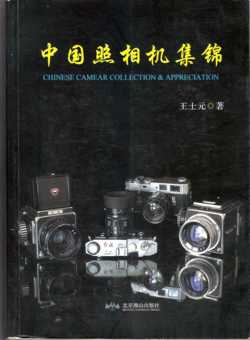
This 413-page, paperback book contains more than 20 types and more than 1,000 Chinese-made and foreign imitation cameras,
which are the crystallization of the author's own collection in the past 30 years.
Each camera has a brief introduction, production year, and comments mentioned in this book
that come from the author's physical examination and analysis of the cameras,
as well as referring to the manufacturer's historical materials, product manuals and other public materials.
The text is entirely in Chinese, and has not been translated, but contains well over 1,000 excellent color photos of the individual cameras -- many of which are subminiatures.
-
Kathy Wersen, Fujica 35mm Camera Guide, 1967 -- This book covers the
many Fuji cameras of the time, which included several half-frame models.
It covers operations of the Fuji Half, Fuji Drive, Fuji Half 1.9, and
Fuji Mini models. This book should NOT be confused with the Fujica
Camera Guide by Joe Cooper. Both books have very similar titles and
are even published by the same company! And even though Joe Cooper
was an expert in submini cameras, his book does NOT describe ANY Fuji submini
camera. Go figure!
William White, Subminiature Photography , 1990
--
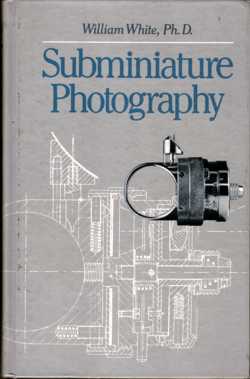
The bible on the history and technique of subminiature photography, he
even devotes chapters to the history and technique of espionage. The
coverage of the history of the submini is excellent. So are the sections
of the various styles of cameras. Two hundred and sixty two pages of
everything you ever wanted to know about subminis.
-
William White, The Microdot: History and Application, 1992 -- This book is a fascinating
read if you are interested in the art of spying, the history of photography, the history and development of film,
or the use of Microdots in the American Civil War (!), Franco Prussian War, Russo-Japanese War, World War I, World War II, and the cold war.
It also explores potential future uses of Microdots. The book is hard cover, 9x11 inches, 158 pages, and contains approximately
80 illustrations and detailed drawings. It is a non-technical book that can be read and understood by anyone.
-
John Williams, Image Clarity: High Resolution Photography , 1990 --
It's a bit on the technical side, but it will help you get the best possible
results from those teeny-tiny, subminiature negatives. It covers details
that you never even imagined. Is it possible to compare a submini image
to a large-format result?
-
D. Scott Young, Minox – Marvel
in Miniature, 2000 --
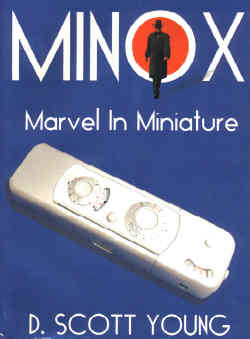
This is the latest book devoted exclusively to Minox 8 x 11 cameras, and
covers all of the models, new and old. The book is 185 pages, in large paperback
format, with tons of illustrations. It is divided into two sections, the
first being a history of the camera line and the inventor, the second being
a primer in photography with specifics geared to the Minox user. Specific
points of interest to a reader include a personal interview with Walter Zapp,
the inventor, and correspondence and articles that have not appeared previously
in America.








